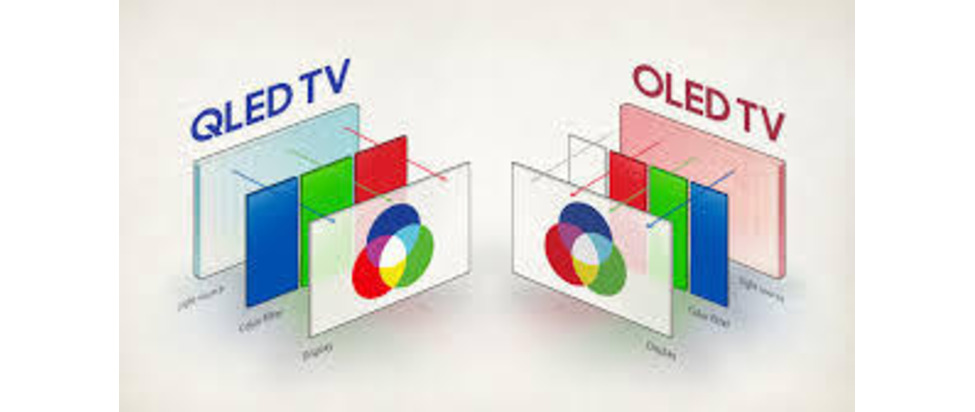When it comes to choosing between QLED and OLED displays, it’s like standing at a crossroads with each path leading to a different visual experience. Picture quality, brightness, contrast, longevity, and price all play crucial roles in determining the best technology for your needs.
However, before making your decision, there’s one key aspect you shouldn’t overlook that could ultimately sway your choice in favor of one over the other.
Picture Quality Comparison
When comparing picture quality, focus on clarity and color accuracy to make the best choice for your display technology needs. Clarity refers to the sharpness and detail visible in images on a screen. Look for technologies like OLED which offer deep blacks and vibrant colors, providing a more lifelike viewing experience. OLED pixels emit their light individually, allowing for true blacks and precise control over brightness levels, resulting in superior clarity compared to traditional LCD displays.
Color accuracy is another crucial aspect to consider when assessing picture quality. Vibrant, true-to-life colors can greatly enhance your viewing experience, whether you’re watching movies, playing games, or editing photos. OLED displays typically excel in color accuracy, with each pixel producing its light and color independently. This feature results in more accurate and vibrant colors across the entire color spectrum.
Brightness and Contrast Differences
To further enhance your understanding of display technology, explore the differences in brightness and contrast capabilities among various options available. When comparing QLED and OLED displays, one key distinction lies in their brightness levels. QLED technology typically offers higher peak brightness compared to OLED, making it ideal for well-lit rooms where combating glare is essential.
On the other hand, OLED excels in contrast ratios, providing deeper blacks and better shadow detail due to its ability to completely turn off individual pixels, resulting in an infinite contrast ratio. This feature makes OLED displays stand out in dark room settings, offering an immersive viewing experience with unparalleled depth and realism.
Consider your viewing environment and preferences when deciding between QLED and OLED. If you prioritize brightness for a well-lit room, QLED might be the better choice. For those who value superior contrast and rich blacks in a darker setting, OLED could be the ideal option. Understanding these differences in brightness and contrast will help you make an informed decision when selecting the right display technology for your needs.
Longevity and Performance Factors
Consider the durability and efficiency of display technology by evaluating longevity and performance factors.
When comparing QLED and OLED displays, longevity plays a crucial role. OLED panels are susceptible to burn-in, where static images can cause permanent damage over time. On the other hand, QLED technology doesn’t face this issue, making it more durable in the long run.
In terms of performance, OLEDs provide unparalleled picture quality with true blacks and vibrant colors due to individual pixel illumination. However, QLEDs offer higher peak brightness levels, making them ideal for well-lit rooms and HDR content.
When it comes to response time, OLEDs have an advantage, delivering smoother motion in fast-paced scenes. QLEDs, though slightly behind in this aspect, still provide excellent performance for most users.
Consider your usage patterns and priorities to determine which technology aligns best with your needs for longevity and performance.
Price Considerations
Price plays a significant role in deciding between QLED and OLED display technologies. When considering price, it’s important to note that QLED TVs generally tend to be more affordable upfront compared to OLED TVs. The manufacturing process of QLED panels is considered less expensive, which often translates to a lower price point for consumers. On the other hand, OLED panels are typically more costly to produce, making OLED TVs generally more expensive to purchase.
While QLED TVs are priced more competitively, it’s essential to weigh the cost against the specific features and performance each technology offers. OLED TVs are known for their superior picture quality, with deeper blacks and better contrast ratios, which may justify the higher price for some consumers. On the contrary, if budget constraints are a primary concern, QLED TVs provide a good compromise between performance and affordability.
Ultimately, when making a decision based on price, consider your budget alongside your priorities in display quality and features to determine the best fit between QLED and OLED technologies.
Which Technology Is Right for You?
When deciding between QLED and OLED display technologies, your choice should align with your priorities in terms of display quality and features. If you value deep blacks, vibrant colors, and wide viewing angles, OLED might be the right choice for you.
OLED screens offer true black levels and excellent contrast ratios, providing a more immersive viewing experience, especially in dark rooms. On the other hand, if you prioritize brightness, color accuracy, and longevity, QLED displays could be more suitable.
QLED technology offers higher peak brightness levels, making it ideal for well-lit rooms or environments where glare might be an issue. Additionally, QLED panels tend to be more energy-efficient and have a longer lifespan compared to OLED screens.
Consider how you use your display, the lighting conditions in your space, and the specific features that matter most to you before making a decision between QLED and OLED.
Conclusion
When choosing between QLED and OLED display technologies, it ultimately comes down to personal preference and budget. QLED offers superior brightness and color accuracy, while OLED provides deeper blacks and wider viewing angles.
Consider your viewing habits, room lighting, and budget before making a decision. Both technologies have their strengths and weaknesses, so choose the one that best suits your needs and enjoy the stunning picture quality they both offer.

